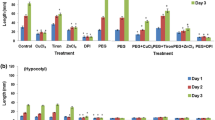Summary
The oxidizing power of rice roots comprises two components,i. e., oxygen release and enzymatic oxidation as measured by α-naphthylamine oxidation. Microscopic examination of roots shows a columnar arrangement of cells having structural intercellular spaces that may serve as air passage pipes in the tip region of the root. Both oxygen release and α-naphthylamine oxidation were studied as function of atmospheric oxygen concentration, light, temperature of root environment, respiratory inhibitors, and nutritional status of the plant. The results led to the concept that α-naphthylamine oxidation is a part of the respiration, and that the oxygen which is not consumed by respiration is diffused into the surrounding environment. Both processes are governed by molecular oxygen supply from shoots. At 25°C, the oxygen release of 3-week-old seedlings of IR36 was about 9 times greater than the amount of oxygen needed to account for α-naphthylamine oxidation rate.
Similar content being viewed by others
References
Armstrong W 1967 The use of polarography in the assay of oxygen diffusion from roots in anaerobic media. Physiol. Plant. 20, 540–553.
Armstrong W 1967 The oxidizing activity of roots in waterlogged soils. Physiol. Plant. 20, 920–926.
Armstrong W 1969 Rhizosphere oxidation in rice: an analysis of intervarietal differences in oxygen flux from the roots. Physiol. Plant. 22, 296–303.
Cannon W A 1932 Absorption of oxygen by roots when the shoot is in darkness or in light. Plant Physiol. 7, 673–684.
Jayawardena S D G, Watanabe T and Tanaka D 1977 Relation between root oxidizing power and resistance to iron toxicity in rice. The Report of the Soc. of Crop Sci. and Breeding in Kinki (Japan) No. 22, 38–47.
Jensen C R, Stolzy L H and Letey J 1967 Tracer studies of oxygen diffusion through roots of barley, corn, and rice. Soil Sci. 103, 23–29.
John C D, Limpinuntana V and Greenway H 1974 Adaptation of rice to anaerobiosis. Aust. J. Plant Physiol. 1, 513–520.
John C D and Greenway H 1976 Alcohol fermentation and activity of some enzymes in rice roots under anaerobiosis. Aust. J. Plant Physiol. 3, 325–336.
Joshi M M, Ibrahim I K A and Hollis J P 1975 Hydrogen sulfide: effects on the physiology of rice plants and relation to straighthead disease. Phytopathology 65, 1165–1170.
Lin C K 1946 Effect of oxygen and sodium thioglycolate on growth of rice. Plant Physiol. 21, 304–318.
Matsunaka S 1960 Studies on the respiratory enzyme systems of plants. I. Enzymatic oxidation of α-naphthylamine in rice plant root. J. Biochem. 47, 820–829.
Mitsui S and Kumazawa K 1961 Dynamic studies on the nutrient uptake by crop plants. Part 36. J. Sci. Soil Manure (Japan) 32, 433–439.
Mitsui S, Kumazawa K and Horiguchi T 1961 Dynamic studies on the nutrient uptake by crop plants. Part 37. J. Sci. Soil Manure (Japan) 32, 455–460.
Mulleriyawa R P 1966 Some factors influencing bronzing—physiological disease of rice in Ceylon. Master's thesis, University of the Philippines at Los Baños.
Okajima H 1958 On the relationship between the nitrogen deficiency of the rice plant roots and reduction of the medium. J. Sci. Soil Manure (Japan) 29, 175–180.
Sakai Y and Yoshida T 1957 Studies on the conditions affecting the outbreak of physical damping of rice seedlings, so-called “Murenae” in frame nursery. Part 1. Observation on the oxidative activity of roots by means of α-naphthylamine oxidation. Hokkaido, Japan Natl. Agric. Exp. Std. 72, 82–91.
Tadano T 1976 Studies on the methods to prevent iron toxicity in the lowland rice. Memoires of the Faculty of Agriculture, Hokkaido University 10 (1), 22–68.
van Raalte M H 1940 On the oxygen supply of rice roots. Ann. Jard. Bot. Buitenzorg 50, 90–113.
Vlamis J and Davis A R 1944 Effects of oxygen tension on certain physiological responses of rice, barley, and tomato. Plant Physiol. 19, 33–51.
Yamazaki T 1952 Studies on the “excess moisture injury” of uplant crops in overmoist soil from the view point of soil chemistry and plant physiology. Bull. Nat. Inst. Agric. Sci. (Tokyo) B 1, 1–92.
Yoshida S, Forno D A, Cock J H and Gomez K A 1972 Laboratory Manual for Physiological Studies of Rice. pp 53–57. International Rice Research Institute, Los Baños, Philippines.
Yoshida S and Tadano T 1978 Adaptation of plants to submerged soils, in crop tolerance to suboptimal land conditions. Ed. G A Jungeaet al. Amer. Spc. Agron., Crop Sci. Soc. Amer., Soil Sci. Amer., Madison, Wisconsin, pp 233–256.
Author information
Authors and Affiliations
Rights and permissions
About this article
Cite this article
Ando, T., Yoshida, S. & Nishiyama, I. Nature of oxidizing power of rice roots. Plant Soil 72, 57–71 (1983). https://doi.org/10.1007/BF02185094
Received:
Revised:
Issue Date:
DOI: https://doi.org/10.1007/BF02185094




